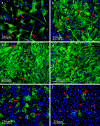Optimized and efficient preparation of astrocyte cultures from rat spinal cord
- PMID: 19002867
- PMCID: PMC3449418
- DOI: 10.1007/s10616-006-9033-4
Optimized and efficient preparation of astrocyte cultures from rat spinal cord
Abstract
Astrocytes constitute a major class of glial cells in the CNS, and play crucial roles in physiological functioning, performance and maintenance of the CNS, as well as promotion of neuronal migration and maturation. Astrocytes have also been directly and indirectly implicated in the pathophysiology of various trauma occurrences, development of neurodegenerative diseases and nerve regeneration. To further understand mechanisms by which astrocytes elicit these effects, the first critical step in the study of astrocytes is the preparation of purified astrocytes cultures. Here we describe a simple and convenient procedure for producing rat primary astrocyte cultures of high purity, viability and proliferation. For astrocyte culture, we have optimized the isolation procedures and cultivation conditions including coating substrates, enzyme digestion, seeding density and composition of the culture medium. Using immunofluorescent antibodies against GFAP and OX-42 in combination of Hoechst 33342 fluorescent staining, we found that the purity of the astrocyte cultures was >99%. Astrocytes had high viability as measured by 3-(4, 5-dimethyl-2-yl)-2, 5-diphenyl-2H-tetrazolium bromide (MTT) assay. In addition, flow cytometric analysis was used to measure and observe variations in the cell cycle after 1-2 passages and proliferation of astrocytes was detected with a high percentage of cells stand in S+G(2)/M phase. Therefore, the method described here is ideal for experiments, which require highly pure astrocyte cultures.
Figures





Similar articles
-
Clonal analysis of astrocyte diversity in neonatal rat spinal cord cultures.Development. 1991 Sep;113(1):353-62. doi: 10.1242/dev.113.1.353. Development. 1991. PMID: 1765006
-
A novel and rapid method for culturing pure rat spinal cord astrocytes on untreated glass.J Neurosci Methods. 1998 Mar 13;80(1):75-9. doi: 10.1016/s0165-0270(97)00198-2. J Neurosci Methods. 1998. PMID: 9606052
-
Influence of rat substrain and growth conditions on the characteristics of primary cultures of adult rat spinal cord astrocytes.J Neurosci Methods. 2011 Apr 15;197(1):118-27. doi: 10.1016/j.jneumeth.2011.02.011. Epub 2011 Feb 21. J Neurosci Methods. 2011. PMID: 21345349
-
Astrocyte precursors in neonatal rat spinal cord cultures.J Neurosci. 1992 Jul;12(7):2751-64. doi: 10.1523/JNEUROSCI.12-07-02751.1992. J Neurosci. 1992. PMID: 1613556 Free PMC article.
-
The use of astrocytes in culture as model systems for evaluating neurotoxic-induced-injury.Neurotoxicology. 1991 Fall;12(3):505-17. Neurotoxicology. 1991. PMID: 1684034 Review.
Cited by
-
Therapeutical Strategies for Spinal Cord Injury and a Promising Autologous Astrocyte-Based Therapy Using Efficient Reprogramming Techniques.Mol Neurobiol. 2016 Jul;53(5):2826-2842. doi: 10.1007/s12035-015-9157-7. Epub 2015 Apr 12. Mol Neurobiol. 2016. PMID: 25863960 Review.
-
Evidence for heterogeneity of astrocyte de-differentiation in vitro: astrocytes transform into intermediate precursor cells following induction of ACM from scratch-insulted astrocytes.Cell Mol Neurobiol. 2010 Apr;30(3):483-91. doi: 10.1007/s10571-009-9474-3. Epub 2009 Nov 3. Cell Mol Neurobiol. 2010. PMID: 19885729 Free PMC article.
-
Sonic Hedgehog Effectively Improves Oct4-Mediated Reprogramming of Astrocytes into Neural Stem Cells.Mol Ther. 2019 Aug 7;27(8):1467-1482. doi: 10.1016/j.ymthe.2019.05.006. Epub 2019 May 16. Mol Ther. 2019. PMID: 31153826 Free PMC article.
-
Methods of Protection of Electrochemical Sensors against Biofouling in Cell Culture Applications.ACS Omega. 2024 Jan 18;9(4):4572-4580. doi: 10.1021/acsomega.3c07660. eCollection 2024 Jan 30. ACS Omega. 2024. PMID: 38313548 Free PMC article.
-
Fibroblast growth factor 4 is required but not sufficient for the astrocyte dedifferentiation.Mol Neurobiol. 2014 Dec;50(3):997-1012. doi: 10.1007/s12035-014-8649-1. Epub 2014 Feb 9. Mol Neurobiol. 2014. PMID: 24510312
References
-
- Aronica E, Catania MV, Geurts J, Yankaya J, Troost D. Immunohistochemical localization of group I and II metabotropic glutamate receptors in control and amyotrophic lateral sclerosis human spinal cord: upregulation in reactive astrocytes. Neurosci. 2001;105:509–520. doi: 10.1016/S0306-4522(01)00181-6. - DOI - PubMed
-
- Aronica E, Gorter JA, Ijlst-Keizers H, Rozemuller AJ, Yankaya B, Leonstra Troost D. Expression and functional role of mGluR3 and mGluR5 in human astrocytes and glioma cells: opposite regulation of glutamate transporter proteins. Eur J Neurosci. 2003;17:1–13. doi: 10.1046/j.1460-9568.2003.02657.x. - DOI - PubMed
LinkOut - more resources
Full Text Sources
Other Literature Sources
Miscellaneous

